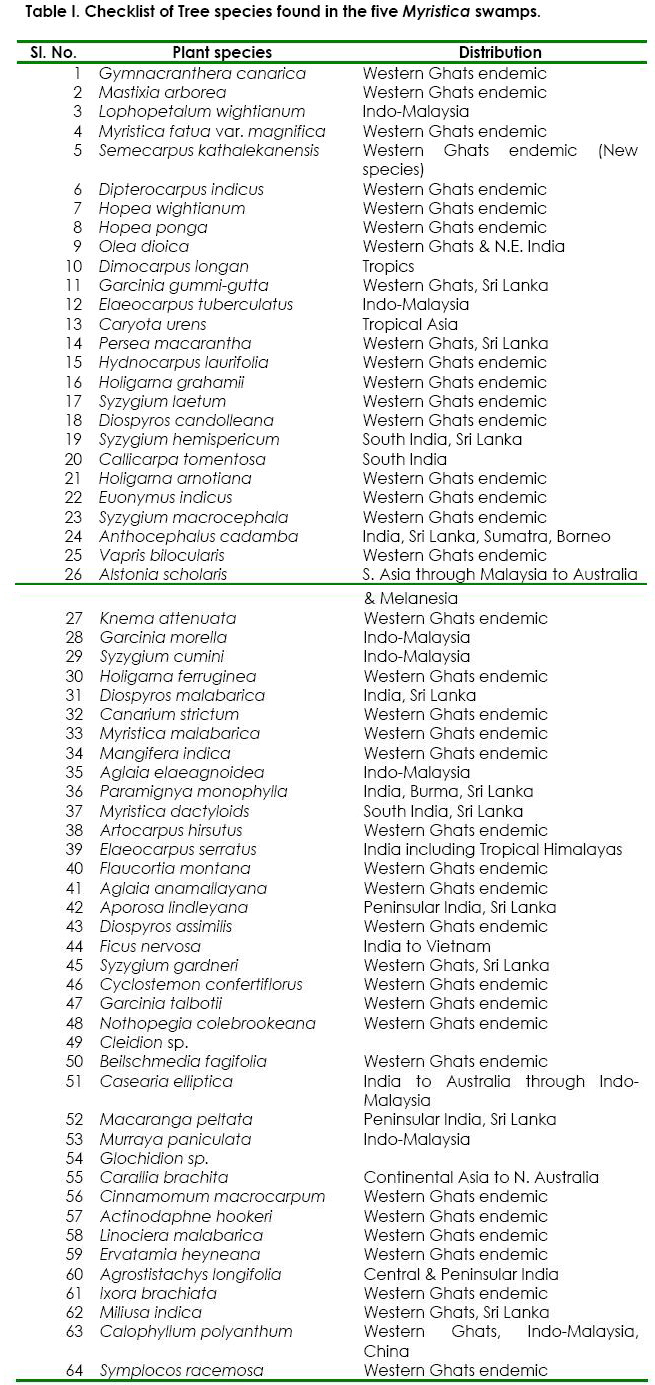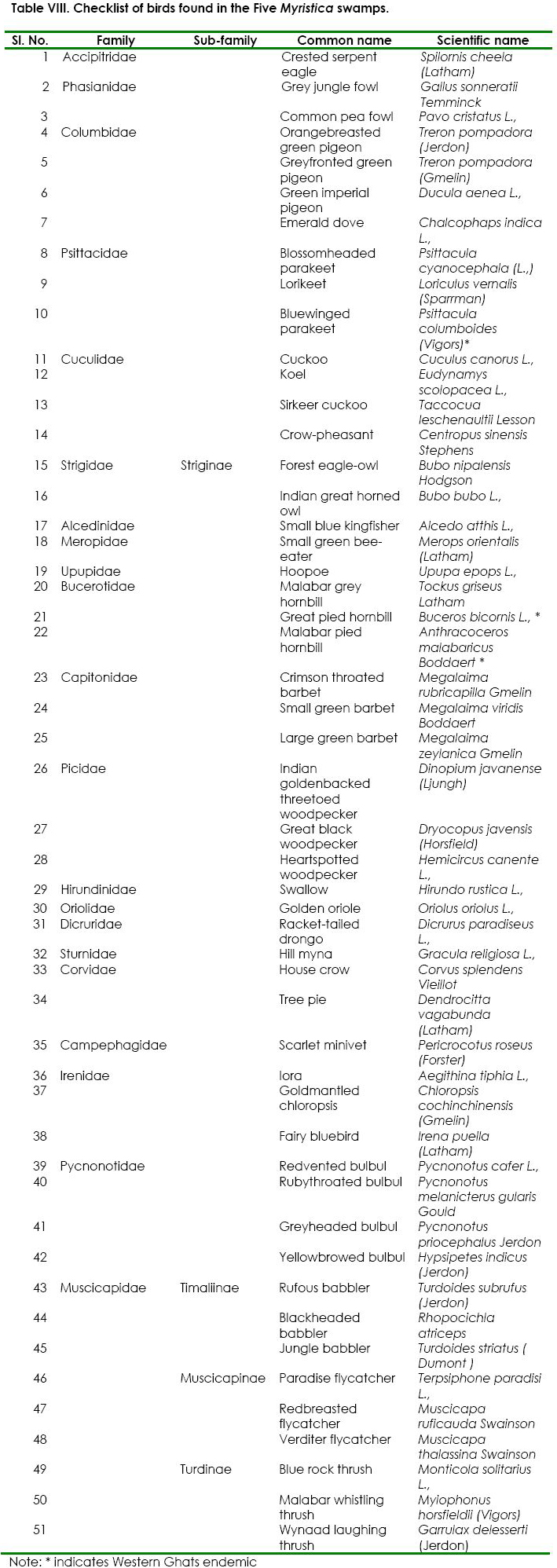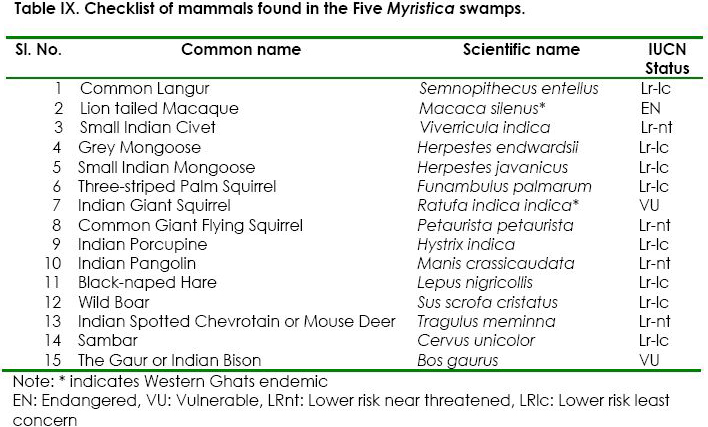 |
Faunal assemblages in Myristica swamps of Central Western Ghats, Karnataka, India |
 |
| Sameer Ali, M D Subash Chandran and T V Ramachandra Energy and Wetlands Research Group, Centre for Ecological Sciences, Indian Institute of Science, Bangalore 560 012 E Mail: cestvr@ces.iisc.ac.in |
Results and Discussion Flora
Notable of the ground layer are rare shrubs and herbs like Apama siliquosa, Ochlandra scriptoria, Calamus spp., Arenga wightii, Pandanus spp., Nothopodytes foetida, Alpinia malaccensis, Jerdonia indica, Neurocalyx calycinus Begonia maabarica and Schumanniatus virgatus. An aroid Lagenandra ovata, and Elatostemma lineolatum and Pellionia heyneana, both members of Urticaceae, are found abundantly in all the surveyed swamps. Pinanga dicksonii, a slender endemic palm of the Western Ghats, grows gregariously in all the swamps. In case of ground layer 7 species are endemic to Western Ghats. The notable of the Pteridophytes are Angiopteris evecta, Bolbitis appendiculata, Cyathea nilgiriensis, Osmunda regalis, Pronephrium triphyllum, Selaginella, Pteris, Staenochlaena palustris and Tectaria wigthii. Fauna About six species of damselflies are found in these swamps (see Table III) including Phylloneura westermanni, which is a range extension from Coorg and Wayanad. Other species are, Clear-winged Forest glory (Vestalis gracilis), Malabar torrent dart (Euphea fraseri), Stream ruby (Rhinocypha bisignata), Black-tipped forest glory (Vestalis apicalis) and Pied reed tail (Protosticta gravelyi). Most of the species are found along the perennial stream inside the swamp. Clear-winged Forest glory (Vestalis gracilis) is found in the undergrowth of interior forest areas.
About 109 species of butterflies representing five families (see Table IV) are found in the Myristica swamps. Family Nymphalidae is dominated by 43 species followed by Papilionidae 16, Pieridae 13, Lycaenidae 18 and Hesperiidae 19 species. Many species are found basking in the open canopy areas. Malabar tree nymph (Idea malabarica), an endemic species found in moist, shady areas and in two swamps was observed to form congregations. Evening browns and Bush browns of family nymphalidea are found in the thick litter covered areas and in the vicinity of Ochlandra scriptoria, Calamus spp. The members of the family Hesperiidae are found in the swamp edges, grasslands and open canopy areas.
16 species of fishes are found in the perennial streams of these swamps (see Table V). Most of them are generalist species found in the Western Ghats. Garra gotyla stenorhynchus, Rasbora daniconius, Danio aequipinnatus are prominent species.
About 29 species of amphibians are listed from the five Myristica swamps (see Table VI). Order Anura comprises eight families and Gymnophiona comprises the family Ichtyophiidae. The family Dicroglossidae and Rhacophoridae comprises seven species each. Whereas, the family Nyctibatrachidae and Ranidae comprise three species each. Some of the notable species are Micrixalus saxicola Nyctibatrachus major, N. petraeus Philautus ponmudi, P. neelanethrus, Polypedatus pseudocruciger and Rhacophorus malabaricus.
21 species of reptiles include 13 species of snakes found in the surveyed swamps (see Table VII). The notable snakes are Python (Python molurus), King cobra (Ophiophagus hannah), Humpnosed pit viper (Hypnale hypnale), Malabar pit viper (Trimersurus malabaricus), Trinket snake (Elaphe helena helena), etc.
About 59 species of birds are found in these swamps (see Table VIII). Some of the endemic species like, Wynaad laughing thrush (Garrulax delesserti), Great pied hornbill (Buceros bicornis), Bluewinged parakeet (Psittacula columboides) are found in all the five surveyed swamps. Indian great horned owl (Bubo bubo L.,), is a common species found in the riparian vegetation of Kathalekan, Halsolli and Torme swamps. Other species like, Fairy bluebird (Irena puella), Malabar whistling Thrush (Myiophonus horsfieldii) and Wagtails are found along the perennial streams.
About 15 species of mammals are found in these swamps (see Table IX), which include an endemic and endangered primate Lion tailed macaque (Macaca silenus). This species is associated with the relics of the primary forests in Siddapur, having the Myristica swamps and Dipterocapus.
|
| E-mail | Sahyadri | ENVIS | GRASS | Energy | CES | CST | CiSTUP | IISc | E-mail |








